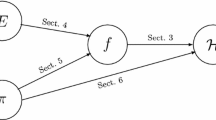Abstract
We define a new black-box property of cryptographic hash function families H:{0,1}K×{0,1}* → {0,1}y which guarantees that for a randomly chosen hash function H K from the family, everything “non-trivial” we are able to compute having access to the key K, we can compute only with oracle access to H K . If a hash function family is pseudo-random and has the black-box property then a randomly chosen hash function H K from the family is resistant to all non-trivial types of attack. We also show that the HMAC domain extension transform is Prf-BB preserving, i.e. if a compression function f is pseudo-random and has the black-box property (Prf-BB for short) then HMACf is Prf-BB. On the other hand we show that the Merkle-Damgård construction is not Prf-BB preserving. Finally we show that every pseudo-random oracle preserving domain extension transform is Prf-BB preserving and vice-versa. Hence, Prf-BB seems to be an all-in-one property for cryptographic hash function families, which guarantees their “total” security.
Research supported by VEGA grant No. 1/0266/09 and Comenius University grant No. UK/429/2010.
Access this chapter
Tax calculation will be finalised at checkout
Purchases are for personal use only
Preview
Unable to display preview. Download preview PDF.
Similar content being viewed by others
References
Bellare, M., Canetti, R., Krawczyk, H.: Keying Hash Functions for Message Authentication. In: Koblitz, N. (ed.) CRYPTO 1996. LNCS, vol. 1109, pp. 1–15. Springer, Heidelberg (1996)
Bellare, M., Ristenpart, T.: Hash Functions in the Dedicated-Key Setting: Design Choices and MPP Transforms. In: Arge, L., Cachin, C., Jurdziński, T., Tarlecki, A. (eds.) ICALP 2007. LNCS, vol. 4596, pp. 399–410. Springer, Heidelberg (2007)
Bellare, M., Ristenpart, T.: Multi-Property-Preserving Hash Domain Extension and the EMD Transform. In: Lai, X., Chen, K. (eds.) ASIACRYPT 2006. LNCS, vol. 4284, pp. 299–314. Springer, Heidelberg (2006)
Bellare, M., Rogaway, P.: Random oracles are practical: a paradigm for designing efficient protocols. In: 1st ACM Conference on Computer and Communications Security, pp. 62–73. ACM (1993)
Canetti, R., Goldreich, O., Halevi, S.: The random oracle methodology, revisited. Journal of the ACM 51(4), 557–594 (2004)
Coron, J.-S., Dodis, Y., Malinaud, C., Puniya, P.: Merkle-Damgård Revisited: How to Construct a Hash Function. In: Shoup, V. (ed.) CRYPTO 2005. LNCS, vol. 3621, pp. 430–448. Springer, Heidelberg (2005)
Damgård, I.B.: A Design Principle for Hash Functions. In: Brassard, G. (ed.) CRYPTO 1989. LNCS, vol. 435, pp. 416–427. Springer, Heidelberg (1990)
Dodis, Y., Ristenpart, T., Shrimpton, T.: Salvaging Merkle-Damgård for Practical Applications. In: Joux, A. (ed.) EUROCRYPT 2009. LNCS, vol. 5479, pp. 371–388. Springer, Heidelberg (2009)
Maurer, U., Renner, R., Holenstein, C.: Indifferentiability, Impossibility Results on Reductions, and Applications to the Random Oracle Methodology. In: Naor, M. (ed.) TCC 2004. LNCS, vol. 2951, pp. 21–39. Springer, Heidelberg (2004)
Merkle, R.C.: One Way Hash Functions and DES. In: Brassard, G. (ed.) CRYPTO 1989. LNCS, vol. 435, pp. 428–446. Springer, Heidelberg (1990)
Rjaško, M.: Black-Box Property of Cryptographic Hash Functions. Cryptology ePrint Archive, Report 2010/631
Rogaway, P., Shrimpton, T.: Cryptographic Hash-Function Basics: Definitions, Implications, and Separations for Preimage Resistance, Second-Preimage Resistance, and Collision Resistance. In: Roy, B., Meier, W. (eds.) FSE 2004. LNCS, vol. 3017, pp. 371–388. Springer, Heidelberg (2004)
Author information
Authors and Affiliations
Editor information
Editors and Affiliations
Rights and permissions
Copyright information
© 2012 Springer-Verlag Berlin Heidelberg
About this paper
Cite this paper
Rjaško, M. (2012). Black-Box Property of Cryptographic Hash Functions. In: Garcia-Alfaro, J., Lafourcade, P. (eds) Foundations and Practice of Security. FPS 2011. Lecture Notes in Computer Science, vol 6888. Springer, Berlin, Heidelberg. https://doi.org/10.1007/978-3-642-27901-0_14
Download citation
DOI: https://doi.org/10.1007/978-3-642-27901-0_14
Publisher Name: Springer, Berlin, Heidelberg
Print ISBN: 978-3-642-27900-3
Online ISBN: 978-3-642-27901-0
eBook Packages: Computer ScienceComputer Science (R0)




